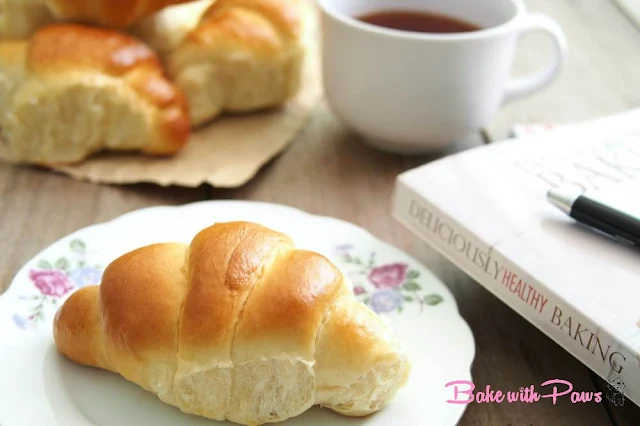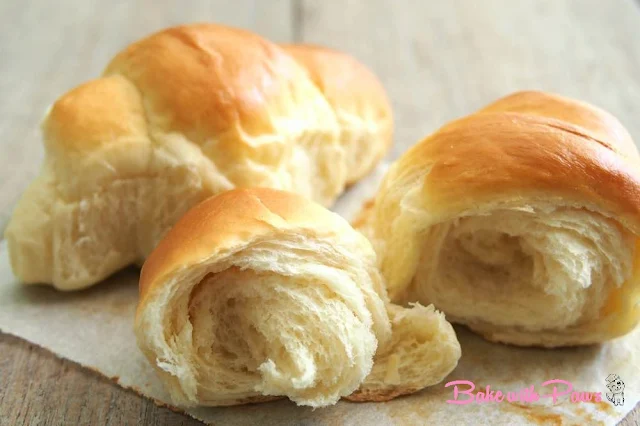Breads (Yeast) - Buns/Rolls
Soft Bun Using Overnight Dough (16-hour poolish version)
July 19, 2017
| Recipe by Bake with Paws
Scroll to the bottom of the page for "PRINT RECIPE" ⬇
If you have any questions regarding this recipe or any other post, please leave me a comment in the “LEAVE A COMMENT” link and I will reply you as soon as possible. Do tag me on Instagram @Bakewithpaws if you attempt on this recipe.
How To Make Soft Bun using Overnight Dough (Poolish Dough Method)
Yields: 12 Buns
INGREDIENTS:
Poolish Dough:
150g bread flour
150g lukewarm water
0.5g (1/8 teaspoon) instant yeast
Main Dough:
250g bread flour
100g cake flour or plain flour
All the poolish dough
15g milk powder
50g caster sugar
6g (1 1/4 teaspoons) salt
5g (1 1/4 teaspoons) instant yeast
1 egg, lightly beaten
75g (approx.) lukewarm water, adjust as necessary
50g butter, cut into small cubes
Egg Wash:
1 egg + 1 Tbsp water, whisked
Utensil:
Baking Tray
METHOD:
- For the poolish dough:
- Mix all ingredients in a mixing bowl together until incorporated. Cover with cling film and let it prove for about 60 minutes in a warm place, then place into the refrigerator to chill for at least 16 hours. It should be bubbly at this stage. 30 minutes before using, take out the polish from refrigerator to return to room temperature.
- For the main dough:
- Put all ingredients (except butter) in a bowl of stand mixer and knead till the dough come together.
- Add in butter and knead until achieve window pane stage (the dough at this stage should be able to be pulled and stretched into membrane).
- 1st Proofing:
- Form the dough into a round ball and let it rise in a warm place for 60 minutes or until double in size in a large greased bowl, covered with cling film or kitchen towel.
- Shaping (like croissants):
- Punch down the dough to release the air.
- Then divide into 12 equal portions. Shape into each portion into a ball.
- Roll each dough ball into carrot shape of about 15cm long.
- Using a rolling pin, roll out to about 30cm length, then roll up like shaping a croissant
- Place the buns on line baking tray.
- Final Proofing:
- Let the buns rise in a warm place until double in size. It took about 45 - 60 minutes.
- Baking:
- Brush with egg wash and bake in preheated 190°C oven for about 12 to 15 minutes, or until golden brown.
- Remove buns to cool on rack completely.
GENERAL NOTES:
GLUTEN DEVELOPMENT & WINDOWPANE TEST
Gluten forms when flour comes in contact with water. Hydration of the flour causes the sticky and stretchy protein to form, giving structure to the bread. This makes your bread trap air and rise.
Gluten in dough can be developed by autolyse, resting, kneading or folding.
The windowpane test is used to determine whether the dough has been sufficiently kneaded. By gently pulling the dough (or you may pinch off some dough) and trying to stretch it into a thin membrane. If you are able to stretch the dough paper thin and translucent without tearing, then the gluten is fully developed. However, if you can stretch it without tearing but the membrane is not transparent, then the gluten is not yet fully developed.
However, from my experience not all the recipe can achieve a thin and translucent window pane stage easily. For example low hydration and low fat dough. For such recipes, a reasonable window pane is good enough and it can be left to rest. Gluten will continue to develop while resting. Exercising restraint to not over-knead the dough prevents the gluten from being overworked and broken. Some of you may have experienced the dough breaking during the second proofing. It is because the dough is over kneaded.
The total kneading time for me is usually 15 minutes at low speeds except brioche dough with high fat percentage or dough using liquid fat which usually takes a little longer (maybe 18-20 mins).
From my experience, I found that high hydration dough with high percentage of fat will be easy to stretch and achieve a paper thin windowpane stage.
KNEADING TIME
For kneading, please regard the timing provided as an indication only. It is only meant as a guide. Timing may differ depending on the brand of flour and electric mixer used. The protein content may vary from one brand of flour to another.
FLOUR
The right flour plays a very important role in bread making. To achieve fluffy, soft and light bread, I used Japan High Gluten Flour in most of my bread baking. The protein content is around 12 - 13%.
HYDRATION
The liquid measurement given is also a guide. It is advisable to always reserve some liquid and not add it all in one go. This would give you the opportunity to adjust if necessary. If dough is too dry, add the reserve liquid one tablespoon at a time until the right consistency. This is because each flour absorbs water and hydrates differently.
PROOFING
Please note that the proofing timing may also vary depending on your climate and environment. The humidity and temperature at your place will influence how dough rises.
If you are unable to judge by just looking at the dough, you can do the finger poke test:
- First Proofing:
- Lightly flour or oil your finger or knuckle, gently poke in the centre of the dough then remove your finger. If it bounces back immediately without any indentation then it needs more time.
- If the indentation stays and it doesn’t bounce back or if the dough collapses, then the it is over proved.
- If it bounces back just a little, then the dough is ready to be punched down and shaping.
- Second Proofing:
- Lightly press the side of the proved dough with your finger. If it bounces back immediately without any indentation, it means the dough is under proved and needs more time before baking.
- If the indentation stays and it doesn’t bounce back, it means it has been over proved.
- If the indentation slowly bounces back and leave a small indentation, it is ready to bake.
- There will be a final burst of rising once the bread is placed to bake in the oven and it is called oven spring.
WRINKLE TOP OR SHRINKING
If your bread collapses or gets wrinkled on top after removing from oven, it could be because your dough over proved during the second proofing. Please proof until it rises 80 - 90% in size or is slightly below the rim of the pan.
BAKING TEMPERATURE & TIME
Do also note that the baking temperature and timing provided are what works for my oven and should also be regarded as a guide only. Every oven behaves a little differently, so please adjust accordingly for your oven.
Labels:
Breads (Yeast) - Buns/Rolls,





hiii...i really enjoyed reading all your posts. yet, i have some questions in making the very soft buns,
ReplyDelete1. how many days can we store the starter in the fridge? can we store it for about a week?
2. is there any standard for converting the instant yeast with the natural one?
thankyou so much for always sharing. stay healthy & safe!
xx,
cornelia
indonesia
Hi, thank you for visiting my blog and your questions.
Delete1. how many days can we store the starter in the fridge? can we store it for about a week? Can store up to 18 hours. Not advisable to store for longer than that. I never tried to use after 18 hours and I am not sure whether it works.
2. is there any standard for converting the instant yeast with the natural one? May I know what type of natural yeast that you are referring to? So far, I use instant yeast and sourdough starter. I have not explored to others yet.
Cheers :)
Can use sourdough starter instead of instant yeast ?
ReplyDeleteYes, you can if you know how to convert. But, I have plenty of sourdough soft bread recipes that you may like to check out too. Please search under categories at the side bar.
DeleteCan this dough be put in fridge overnight after shaping, to be bake in morning? Thank u!
ReplyDeleteHi, yes you can. But, I will advise to retard in the fridge during first proofing. Shape the next day.
DeleteYou may want to try this recipe which is overnight retard in the fridge:
https://www.bakewithpaws.com/2020/05/soft-and-fluffy-white-sandwich-bread.html
Cheers :)
Hi thanks for sharing the recipe! May I know if the poolish dough is another method or do I add poolish dough to main dough after that?
ReplyDeletesorry for the noob question🤭
Hi, thanks for your interest in this recipe. This recipe use Poolish Dough method. Please add all the poolish when you prepare the main dough.
DeleteCheers :)